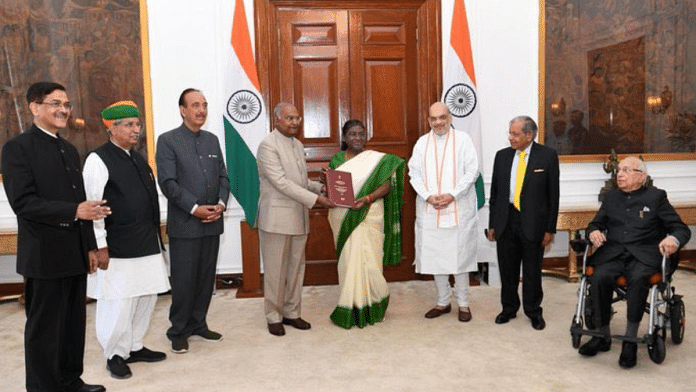New Delhi: As India prepares for the 2024 Lok Sabha elections, Congress president Mallikarjun Kharge has warned that it could very well be the last election, while the BJP has given a rallying cry for ‘Ab ki baar 400 paar’. But it is former President Ram Nath Kovind’s ‘One nation, One Election’ slogan that has caught the zeitgeist this week.
Kovind-led panel’s much-awaited report is in, triggering a buzz that simultaneous elections to the Lok Sabha and legislative assemblies could soon become a part of India’s constitutional democracy.
The panel has recommended a two-step electoral process: first, elections to the Lok Sabha and assemblies, followed by municipal and panchayat polls within 100 days.
To facilitate this, the panel has recommended curtailing the tenure of state assemblies to make it coterminous with the Lok Sabha. Constitutional amendments to this effect won’t need ratification by states, the panel said in its report submitted to President Droupadi Murmu on Thursday.
The report has set alarm bells ringing in the opposition camps, which fear it will be the “death knell for federalism.”
However, in a country that has witnessed 400 elections to Lok Sabha and state assemblies so far, the debate over simultaneous elections is not new. The Law Commission of India had thrice—in 1999, 2015, and 2018 (draft)—argued for simultaneous elections to “free citizens, political parties, and government authorities from the encumbrance of asynchronous elections”.
So did the parliamentary panel on Personnel, Public Grievances, Law and Justice in 2016, which said that holding simultaneous elections would reduce the massive expenditure incurred in holding polls. The panel said that the Election Commission of India (ECI) has pegged the cost of holding simultaneous elections at Rs 4,500 crore.
The latest report by the Kovind-led panel is why ‘One Nation, One Election’ is ThePrint’s Newsmaker of the Week.
Also read: Are simultaneous elections possible when EC can’t even conduct Lok Sabha polls in one day?
When simultaneous elections was the norm
In the initial years after India became independent, elections to the Lok Sabha and state assemblies were conducted simultaneously.
The first general election, held between October 1951 and May 1952, saw a three-step process—electing the President and vice-president, members of the Lower Houses at the Centre and in the states, and members of the Upper Houses. Even the second general election to the Lok Sabha and state legislative assemblies was held at the same time.
Significantly, though, legislative houses of several states were dissolved prematurely to hold simultaneous elections in 1957, according to the ECI’s report on the second general elections, which the Kovind-led panel cited in its report.
But with political instability gaining ground in the decade following 1960, the cycle of simultaneous elections got disrupted. While Punjab, Bihar, and Uttar Pradesh couldn’t complete their tenures on three occasions between 1967 and 1980, Odisha assembly witnessed five elections during that period, and West Bengal assembly witnessed four elections between 1967-1972.
The frequency of holding elections decreased in the subsequent decades. But once the cycle got disrupted, India could never go back to holding simultaneous elections again.
As and when India ushers in ‘One Nation, One Election’, it will not be the first country to do so. In Germany, the Bundestag (Lower House), Landtags (State assembly), and the local elections are held simultaneously. The Philippines too conducts simultaneous elections every three years, though it has a Presidential form of government.
Also read: One nation, one election is BJP’s ‘brahmastra’. It wants state contests to be ‘Modi versus who’, too
Challenges of holding simultaneous elections
While simultaneous elections could prove to be a big saving for the exchequer, there will be challenges in its implementation.
The complex legal procedures that the report of the Kovind panel has proposed for bringing in the constitutional amendments must be weighed carefully to allay the oppositions’ fear of “infringing federalism.”
This includes the suggestion that once the appointed date to bring into force the provisions for transition to simultaneous polls is fixed, the “tenure of all State Legislative Assemblies constituted in any election after the appointed date would come to an end on the expiry of the full term of the House of the People, irrespective of when an Assembly was constituted.”
Though the Kovid panel has said that the constitutional amendments to this effect won’t need ratification by states, curtailment of the tenure of state assemblies before their term ends could invite opposition’s backlash and get challenged in the courts as well.
The report reiterates that altering the tenure of the House/legislative assembly in “no manner impairs” federalism.
That may well be the case, and holding simultaneous elections may be economically viable too. But the opposition may have a point that in pushing for ‘One Nation, One Election’, the Narendra Modi government could well be ignoring the citizens’ right to remove non-performing governments and replace them with better alternatives.
(Edited by Prashant)



